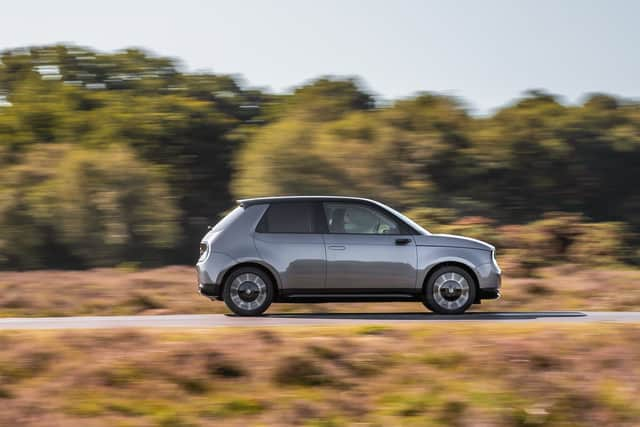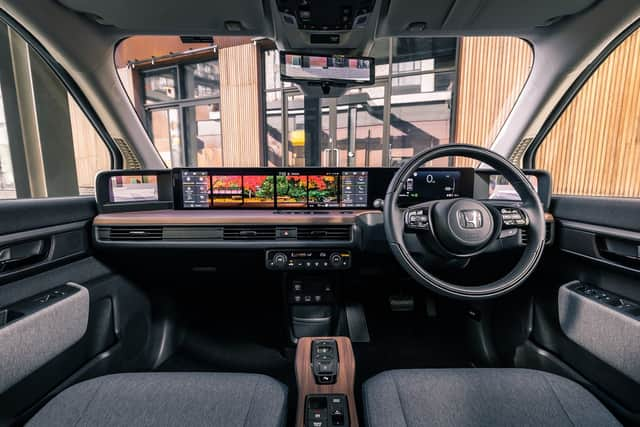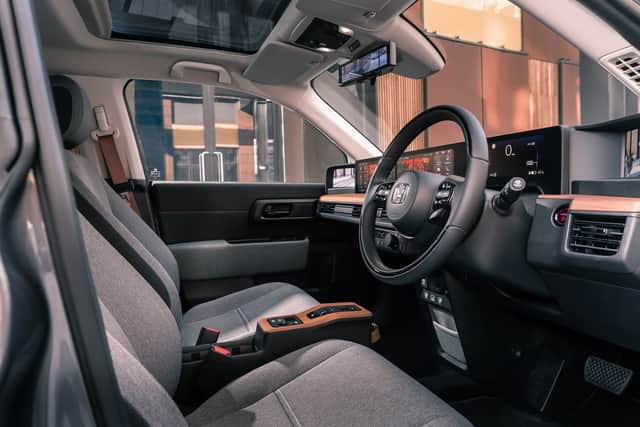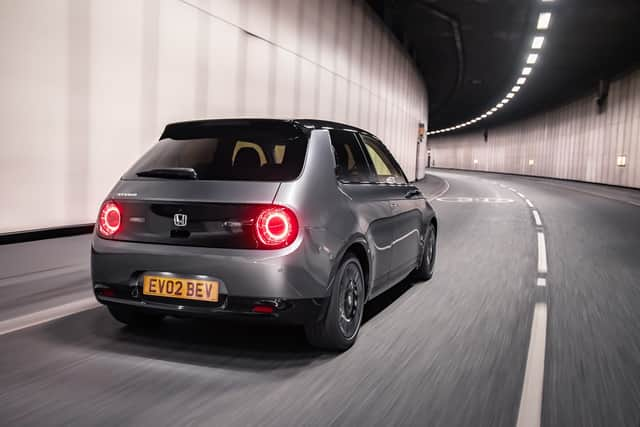Honda e review: electric city car’s characterful charm comes at a price
and live on Freeview channel 276
Back in 2017 Honda caused an absolute storm at the Frankfurt Motor Show when it unveiled the Urban EV Concept.
The ultra-cute electric city car attracted more attention than almost anything else at the show and drew clamours to stick number plates on it and get it into showrooms immediately.
Advertisement
Hide AdAdvertisement
Hide AdOf course, it’s not that simple but four years later Honda had turned the concept into a reality and despite gaining a couple of extra doors and sitting a little taller, it’s remarkable how much of that original show car has made it onto the road.
For a start, it’s still a tiny rear-drive electric city car. And despite compromises for safety and practicality it has kept all of the cheeky charm of the concept with its rounded square styling, circular LED running light “eyes” and touches like door-mounted cameras in place of wing mirrors.


The rear doors are cleverly designed, with hidden handles to give the car as close to a three-door look as possible and it’s a clean smooth look that’s likely to appeal to buyers considering other retro-inspired EVs like the Fiat 500 and Mini Electric.
While the exterior is a study in “noiseless” design, there’s a lot - a lot - more going on inside. Some of it great, some of it less so.
Advertisement
Hide AdAdvertisement
Hide AdI’m all for the lounge ambience, with a warm light “wood” trim, pale sofa-like upholstery and a surprisingly airy feel thanks to a big sunroof. The adjustable centre console puts big simple drive select buttons close at hand and hides a neat slide-out cup holder, while the fabric phone pouch beneath the dashboard is a clever space-saving solution.
Ergonomically and aesthetically, it’s a huge success. However, above all this sits the e’s biggest problem - a massive touchscreen array that stretches from one side of the dashboard to the other. There are five screens in all - two six-inchers for the wing cameras; one 8.8-inch instrument cluster and two 12.3-inch touchscreens that house the media, navigation and communications systems.


The mirror screens work okay and the instrument cluster is clear and packed with useful information but the infotainment is a mess. Honda says the dual screen setup is “highly intuitive” and allows for endless personalisation to ensure driver and passenger have their favourite apps close to hand. You can run two apps side by side, swap apps between screens, set up shortcuts and even turn the whole thing into a digital aquarium when you’re parked. It’s all very clever. And very distracting. Just because you can fit 24 inches of touchscreen to your car doesn’t mean you should and operating it on the move is a distracting nuisance.
This being a 3.9-metre-long city car, don’t expect acres of real estate. There’s reasonable space up front, aided by the completely flat floor and open space in front of the centre console. In the back, though, the two seats are a squeeze and - like the Fiat and Mini - are really for kids and emergency use only. A tiny 171-litre boot is in keeping with the diminutive nature of the whole car.
Advertisement
Hide AdAdvertisement
Hide AdAnother relatively small feature of the e is the battery. A lot of manufacturers are chasing longer and longer ranges but Honda has taken a rational approach to the e. It’s a car designed to live in the city and do city centre mileage, so a huge range isn’t necessary.
As a result, the e’s battery is relatively small. At 35.5kWh, Honda says it is good for an official 137 miles. That’s more or less equal to the Mini Electric but shaded by the Fiat 500 and similarly priced Renault Zoe. A 100kW charging capability does at least mean the battery can be replenished in just 25 minutes, should you find yourself caught short.


There are two versions of the Honda e, both use the same battery but the Advance has a 152bhp motor mounted at the back and powering the rear wheels compared with the standard car’s 134bhp version. Torque for both is the same - a healthy 232lb ft - and the clearest difference is the Advance’s one-second advantage to 62mph.
On the road, that torque means a really immediate and responsive drive, darting off the line with ease. It’s not quite as urgent feeling as the Mini but more than sharp enough for city driving. The same is true for the handling. Sharp steering, a responsive chassis and a ridiculously tight turning circle mean you feel instantly at home in the city, weaving deftly through the cut and thrust of traffic.
Advertisement
Hide AdAdvertisement
Hide AdThat agility along with its city-friendly size are absolutely core to the Honda e’s appeal, along with its unique styling. However, you have to really have fallen in love with the e for it to make financial sense.
At a shade over £31,000 it is noticeably more expensive than a Mini Electric and only the top-spec Fiat 500 La Prima comes close - and that comes with a free home wallbox and 199 miles of range. Hi-tech touches such as adaptive cruise control, auto dipping lights and that ridiculous dashboard array go some way to explaining the high price but, given that a Kia Soul costs £1,700 more and offers space for five plus 250+ miles of range, it does feel like you’re paying a lot for the e’s character.
Honda bosse are gambling that, much like Apple devotees, there’s an audience out there willing to do just that and, if initial responses are any guide, they might well be right.


Honda e Advance
Price: £30,715 after PICG (£31,265 as tested); Motor: Single 113kW synchronous motor; Battery: 35.5kWh; Power: 152bhp; Torque: 232lb ft; Transmission: Fixed-gear ratio, rear-wheel-drive; Top speed: 100mph; 0-62mph: Eight seconds; WLTP range: 282 miles; Consumption: 3.4 miles/kWh; Charging: Up to 100kW
